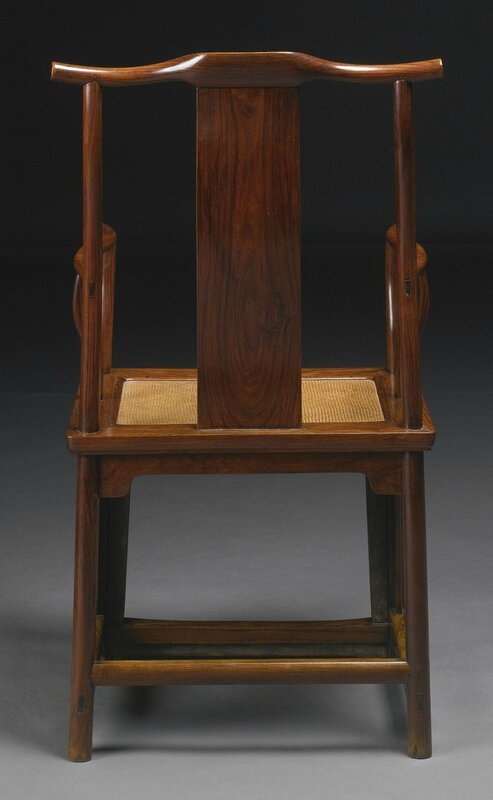A Huanghuali yokeback armchair (sichutou guanmaoyi), Ming dynasty, 17th century
Lot 221. A Huanghuali yokeback armchair (sichutou guanmaoyi), Ming dynasty, 17th century. Height 44 in., 111.8 cm; Width 23 1/2 in., 59.7 cm; Depth 24 1/4 in., 61.6 cm. Estimate 150,000 — 250,000 USD. Lot sold 187,500 USD. Photo Sotheby's 2015
the solidly carved toprail with shaped yoke and upswept flat ends supported on corner posts which continue through to the back legs, centered by a thick, attractively grained S-shaped rectangular back splat, the elongated serpentine arms supported by curved stiles and posts, the hard mat seat above the round-section front legs joined by continuous beaded and cusped aprons, a footrest, and side and back stretchers with plain aprons.
Provenance: Nicholas Grindley, Barling of Mount Street, London July 13, 1992.
Notes: In the late Ming, the elegant simplicity of this imposing and spare form represented the height of grand literati taste. The famed 17th century arbiter of refinement, Wen Zhenheng, in his best known work, Zhang Wu Zhi (Treatise on Superfluous Things) advocated restrained design as exemplified by the present armchair and goes so far as to describe excessive decoration as vulgar. Similar examples of this classic form are illustrated in Wang Shixiang, Connoisseurship of Chinese Furniture, Vol. 2, Hong Kong, 1990, p. 43, fig. A70; and one of a pair illustrated in Nancy Berliner, Beyond the Screen, Museum of Fine Arts, Boston, 1996, p. 104, no. 8.
For a general discussion on the basic model and elegant decorative vocabulary of these chairs, see Curtis Evarts, 'From Ornate to Unadorned, A Study of Yokeback Chairs', Journal of the Chinese Classical Furniture Society, Spring 1993, pp. 24-33. Another fine example of the form but with a foliate carved apron and splat cartouche sold in these rooms 14th September 2011, lot 125 and another of similarly generous dimension but with rounded ends sold in these rooms 20th March 2012, lot 127.
Sotheby's. Important Chinese Works of Art, New York, 17 mars 2015

/https%3A%2F%2Fprofilepics.canalblog.com%2Fprofilepics%2F1%2F0%2F100183.jpg)
/https%3A%2F%2Fstorage.canalblog.com%2F03%2F02%2F119589%2F96711876_o.jpg)
/https%3A%2F%2Fstorage.canalblog.com%2F11%2F31%2F119589%2F94773502_o.jpg)
/https%3A%2F%2Fstorage.canalblog.com%2F20%2F83%2F119589%2F94772815_o.jpg)
/https%3A%2F%2Fstorage.canalblog.com%2F26%2F72%2F119589%2F75604929_o.jpg)
/https%3A%2F%2Fstorage.canalblog.com%2F59%2F60%2F119589%2F26458628_o.jpg)






/http%3A%2F%2Fstorage.canalblog.com%2F32%2F99%2F119589%2F129836631_o.jpg)
/http%3A%2F%2Fstorage.canalblog.com%2F46%2F82%2F119589%2F129704536_o.jpg)
/http%3A%2F%2Fstorage.canalblog.com%2F49%2F48%2F119589%2F129680938_o.jpg)
/http%3A%2F%2Fstorage.canalblog.com%2F64%2F83%2F119589%2F129635530_o.jpg)